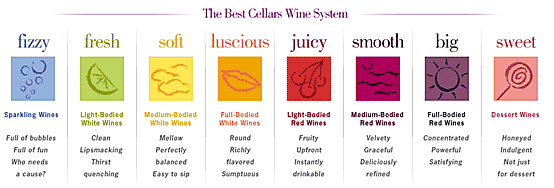October 01, 2004
The Information Architecture of Wine
From the press section of BestCellars.com, comes a story from Wine News about BestCellars' innovative approach to selling wine. It includes this question-and-answer:
So how did this whole thing come about?Most wine stores tend to be organized by grape type, or country of origin. But neither of those organizational directions allow for a consumer who knows nothing about wine to be comfortable. They both presume a certain knowledge and awareness on the part of the consumer, and when you put the onus of knowing what a cabernet or merlot is on the customer, you immediately narrow your customer base. We wanted to democratize the process. We really set about making it as simple as possible.
You've got eight categories set up. In red wine, for example, there are "juicy," "smooth," "big," each modified by several adjectives. Why those adjectives? Why those categories for that matter?
First we started looking at all the adjectives commonly used for wine. We blocked out maybe two hundred and fifty of them on cards, and then aligned the cards in broad sweeps based on attributes we thought would tie to different colors of wine. Then we started to turn over cards that needed a glossary for the average person to comprehend, the words that were understandable only by someone with a substantial knowledge of wine. Then if they were so broad that they were essentially meaningless we got rid of them. In the end we had about thirty words that seemed to work.
I love that a business model is predicated on a way of classification.

